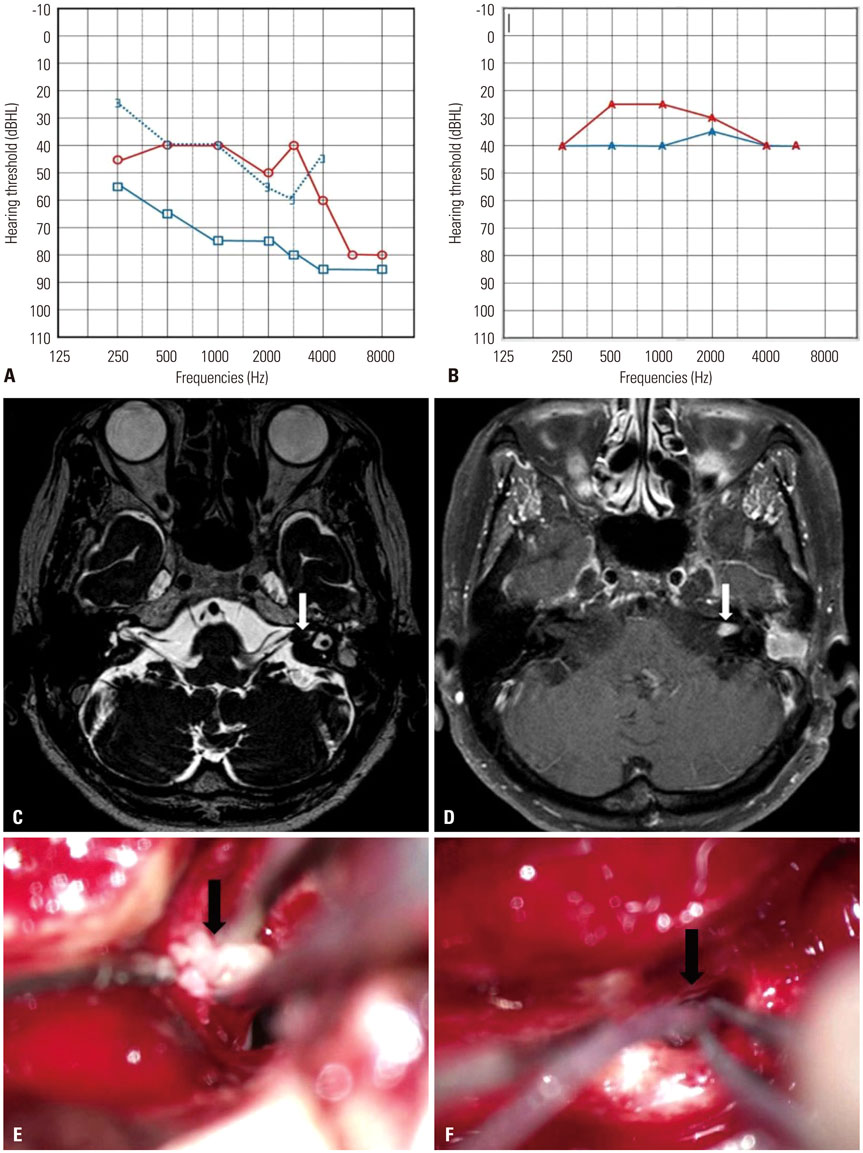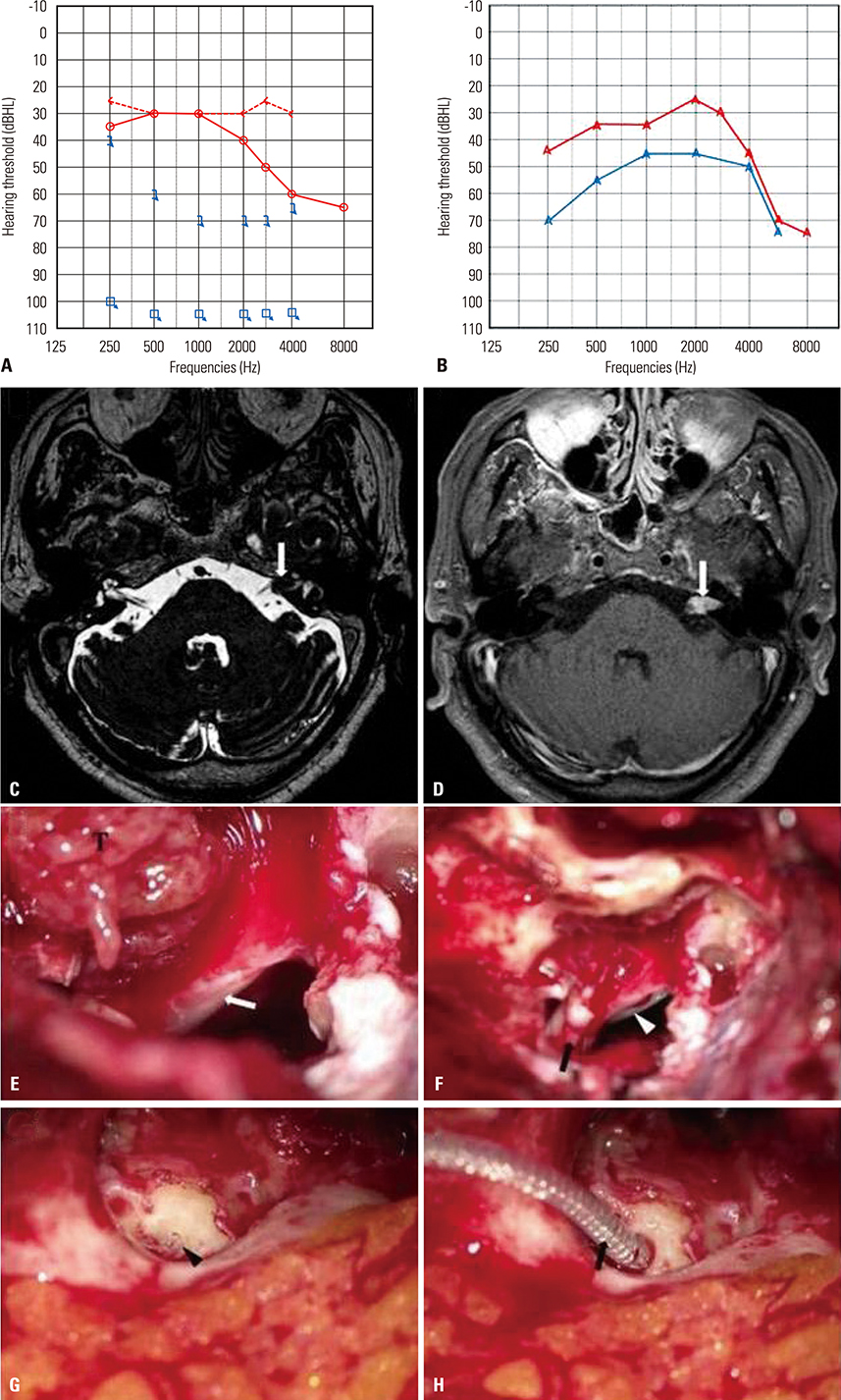Yonsei Med J.
2016 Nov;57(6):1535-1539. 10.3349/ymj.2016.57.6.1535.
Simultaneous Translabyrinthine Tumor Removal and Cochlear Implantation in Vestibular Schwannoma Patients
- Affiliations
-
- 1Department of Otorhinolaryngology, Yonsei University College of Medicine, Seoul, Korea. ismoonmd@yuhs.ac
- KMID: 2427178
- DOI: http://doi.org/10.3349/ymj.2016.57.6.1535
Abstract
- Refinement of surgical techniques has allowed hearing preservation after tumor resection to be prioritized. Moreover, restoration of hearing after tumor removal can be attempted in patients with bilateral vestibular schwannomas or those with a schwannoma in the only-hearing ear. Cochlear implantation (CI) has emerged as a proper method of acoustic rehabilitation, provided that the cochlear nerve remains intact. Studies of electrical promontory stimulation in patients after vestibular schwannoma resection have demonstrated favorable results. We describe herein two cases of hearing rehabilitation via CI implemented at the time of vestibular schwannoma resection. Tumors were totally removed, and cochlear implant electrodes were successfully inserted in both cases. Also, post operative CI-aided hearing showed improved results.
MeSH Terms
Figure
Cited by 1 articles
-
Hearing Restoration in Neurofibromatosis Type II Patients
Jeon Mi Lee, Jin Woo Chang, Jae Young Choi, Won Seok Chang, In Seok Moon
Yonsei Med J. 2016;57(4):817-823. doi: 10.3349/ymj.2016.57.4.817.
Reference
-
1. Lustig LR, Yeagle J, Niparko JK, Minor LB. Cochlear implantation in patients with bilateral Ménière's syndrome. Otol Neurotol. 2003; 24:397–403.
Article2. Cohen NL, Lewis WS, Ransohoff J. Hearing preservation in cerebellopontine angle tumor surgery: the NYU experience 1974-1991. Am J Otol. 1993; 14:423–433.
Article3. Arístegui M, Denia A. Simultaneous cochlear implantation and translabyrinthine removal of vestibular schwannoma in an only hearing ear: report of two cases (neurofibromatosis type 2 and unilateral vestibular schwannoma). Otol Neurotol. 2005; 26:205–210.
Article4. Zanetti D, Campovecchi CB, Pasini S, Nassif N. Simultaneous translabyrinthine removal of acoustic neuroma and cochlear implantation. Auris Nasus Larynx. 2008; 35:562–568.
Article5. Lambert PR, Ruth RA, Halpin CF. Promontory electrical stimulation in labyrinthectomized ears. Arch Otolaryngol Head Neck Surg. 1990; 116:197–201.
Article6. Kartush JM, Linstrom CJ, Graham MD, Kulick KC, Bouchard KR. Promontory stimulation following labyrinthectomy: implications for cochlear implantation. Laryngoscope. 1990; 100:5–9.7. Hoffman RA, Kohan D, Cohen NL. Cochlear implants in the management of bilateral acoustic neuromas. Am J Otol. 1992; 13:525–528.8. Shin YJ, Fraysse B, Sterkers O, Bouccara D, Rey A, Lazorthes Y. Hearing restoration in posterior fossa tumors. Am J Otol. 1998; 19:649–653.9. Tono T, Ushisako Y, Morimitsu T. Cochlear implantation in an intralabyrinthine acoustic neuroma patient after resection of an intracanalicular tumor. Adv Otorhinolaryngol. 1997; 52:155–157.
Article10. Lim HW, Hong SM, Choi SW, Jung JW, Shin J, Chae SW. Availability of Korean hearing in noise test (KHINT) in children. Korean J Otorhinolaryngol-Head Neck Surg. 2011; 54:462–466.
Article11. Moon SK, Mun HA, Jung HK, Soli SD, Lee JH, Park K. Development of sentences for Korean hearing in noise test (KHINT). Korean J Otolaryngol-Head Neck Surg. 2005; 48:724–728.12. Arriaga MA, Marks S. Simultaneous cochlear implantation and acoustic neuroma resection: imaging considerations, technique, and functional outcome. Otolaryngol Head Neck Surg. 1995; 112:325–328.
Article13. Kveton JF, Abbott C, April M, Drumheller G, Cohen N, Poe DS. Cochlear implantation after transmastoid labyrinthectomy. Laryngoscope. 1989; 99(6 Pt 1):610–613.
Article14. Zwolan TA, Shepard NT, Niparko JK. Labyrinthectomy with cochlear implantation. Am J Otol. 1993; 14:220–223.
- Full Text Links
- Actions
-
Cited
- CITED
-
- Close
- Share
- Similar articles
-
- A Case of Intralabyrinthine Schwannoma Removal and Sequential BonebridgeTM Implantation
- Two Cases of Cochlear Implantation in Patients With Unilateral Profound Hearing Loss Due to Intralabyrinthine Schwannoma
- Simultaneous Treatment of Vestibular Schwannoma and Concurrent Middle Ear Disease Using the Enlarged Translabyrinthine Approach
- Balance Problem after Cochlear Implantation
- A Case of Cochlear Implantation in a Patient With Intracochlear Schwannoma



